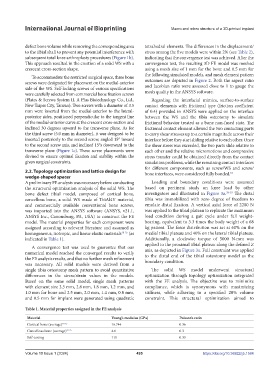Page 503 - IJB-10-1
P. 503
International Journal of Bioprinting Macro and micro structure of a 3D-printed implant
defect bone volume while removing the corresponding area tetrahedral elements. The differences in the displacement/
to the tibial shaft to prevent any potential interference with stress among the five models were within 2% (see Table 2),
subsequent total knee arthroplasty procedures (Figure 1b). indicating that the convergence test was achieved. After the
This approach resulted in the creation of a solid WS with a convergence test, the resulting 3D FE model was meshed
crescent cross-section shape. using a mesh size of 1 mm for the bone and 0.5 mm for
To accommodate the restricted surgical space, three bone the following simulated models, and mesh element pattern
screws were designated for placement on the medial-anterior outcomes are depicted in Figure 2. Both the aspect ratio
side of the WS. Self-locking screws of various specifications and Jacobian ratio were assessed close to 1 to gauge the
were carefully selected from commercial bone fixation screws mesh quality in the ANSYS software.
(Plates & Screws System II, A Plus Biotechnology Co., Ltd., Regarding the interfacial mimics, surface-to-surface
New Taipei City, Taiwan). Two screws with a diameter of 3.5 contact elements with frictional type (friction coefficient
mm were inserted from the medial-anterior to the lateral- of 0.4) provided in ANSYS were applied on the interface
posterior sides, positioned perpendicular to the tangent line between the WS and the tibia osteotomy to simulate
of the medial-anterior curve at the crescent cross-section and frictional behavior treated as a bone non-fused state. The
inclined 30 degrees upward to the transverse plane. As for frictional contact element allowed the two contacting parts
the third screw (5.0 mm in diameter), it was designed to be to carry shear stresses up to a certain magnitude across their
inserted posteriorly to the second screw, angled 15° inward interface before they start sliding relative to each other. Once
to the second screw axis, and inclined 15°s downward to the the shear stress was exceeded, the two parts slide relative to
transverse plane (Figure 1c). These screw placements were each other and the relative micromotions and compressive
devised to ensure optimal fixation and stability within the stress transfer could be obtained directly from the contact
given surgical constraints. simulation problems, while the remaining contact interfaces
for different components, such as screw/WS and screw/
2.2. Topology optimization and lattice design for bone interfaces, were considered fully bonded.
10
wedge-shaped spacer
A preliminary FE analysis was necessary before conducting Loading and boundary conditions were assumed
the structural optimization analysis of the solid WS. The based on pertinent study on knee load by other
bone defect tibial model, composed of cortical bone, investigators and illustrated in Figure 3a. 26-29 The distal
cancellous bone, a solid WS made of Ti6Al4V material, tibia was immobilized with zero degree of freedom to
and commercially available conventional bone screws, emulate distal fixation. A vertical axial force of 2200 N
was imported into the ANSYS software (ANSYS, v21.1, was applied to the tibial plateau to replicate the maximum
ANSYS Inc., Canonsburg, PA, USA) to construct the FE load condition during a gait cycle under full weight-
model. The material properties for each component were bearing, equivalent to 3.3 times the body weight of a 68
assigned according to relevant literature and assumed as kg patient. The force distribution was set at 60% on the
homogeneous, isotropic, and linear elastic materials 18-25 (as medial tibial plateau and 40% on the lateral tibial plateau.
indicated in Table 1). Additionally, a clockwise torque of 5000 N·mm was
applied to the proximal tibial plateau along the defined Z
A convergence test was used to guarantee that our
numerical model reached the converged results to verify axis, as depicted in Figure 3a. Full constraint was applied
to the distal end of the tibial osteotomy model as the
the FE analysis results, and that no further mesh refinement boundary condition.
was necessary. All solid models were derived from a
single tibia osteotomy mesh pattern to avoid quantitative The solid WS model underwent structural
differences in the stress/strain values in the models. optimization through topology optimization integrated
Based on the same solid model, single mesh patterns with the FE analysis. The objective was to minimize
with element size 3.5 mm, 2.8 mm, 1.8 mm, 1.2 mm, and compliance, which is synonymous with maximizing
1.0 mm for bone and 2.5 mm, 2.0 mm, 1.4 mm, 0.8 mm, stiffness, while adhering to a specified 20% volume
and 0.5 mm for implant were generated using quadratic constraint. This structural optimization aimed to
Table 1. Material properties assigned in the FE analysis
Material Young’s modulus (GPa) Poisson’s ratio
Cortical bone (average) 18-25 16.744 0.36
Cancellous bone (average) 23-25 4.6 0.3
Self-testing 111 0.33
Volume 10 Issue 1 (2024) 495 https://doi.org/10.36922/ijb.1584

